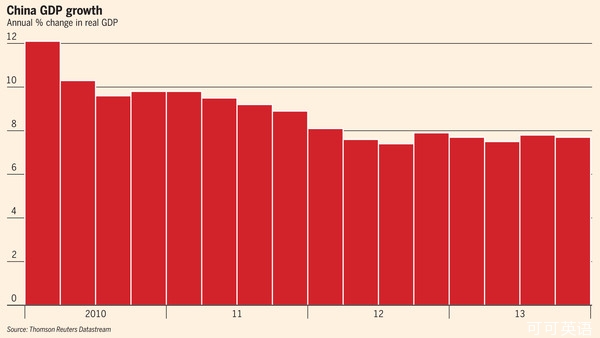
When analysts talk about the past three decades of Chinese economic growth it is often in reverential, quasi-religious terms. China’s 35 years of 9.7 per cent average annual expansion “is a miracle unprecedented in human history”, says Justin Lin Yifu, who was chief economist at the World Bank from 2008 to 2012.
分析师们在谈论过去30年中国的经济增长时,往往会使用满怀敬意的、近乎宗教式的措辞。用曾在2008年至2012年担任世界银行(World Bank)首席经济学家的林毅夫(Justin Lin Yifu)的话来说,中国在35年间实现9.7%的年均增长是“人类历史上不曾有过的奇迹”。
The lifting of 400m to 600m out of poverty could possibly count as a miracle but the model of growth, and the expansion rates, are not unprecedented, even among China’s neighbours.
让4亿至6亿人脱贫,也许可以算作一个奇迹,但这种经济增长模式和增长速度并非不曾有过,其实在中国的周边地区就不乏先例。
“We’ve seen this movie before – in South Korea, Taiwan, Hong Kong, Japan. We’re just seeing a bigger and more colourful version in China,” says Frederic Neumann, co-head of Asian economic research for HSBC. “Japan in the 1960s grew at 10 per cent a year and was considered the miracle economy of the time.”
“我们以前在韩国、台湾、香港、日本看到过这一幕。现在只是在中国看到了一个更大、更丰富多彩的版本。”汇丰(HSBC)亚洲经济研究联席主管范力民(Frederic Neumann)表示,“日本在上世纪60年代每年增长10%,在当时被视为经济奇迹。”
China’s economy expanded 7.7 per cent in 2013, government figures yesterday showed, on par with the revised 7.7 per cent growth rate for 2012. But most analysts expect growth to decelerate this year to its slowest pace in more than two decades. Many are starting to wonder if the similarities between China and its neighbours extend to their downturns as well as their booms.
昨日发布的官方数据显示,中国经济在2013年扩张了7.7%,与2012年修订后7.7%的增长率持平。但多数分析师预计,中国经济增速将在今年放缓至20多年来最低的水平。许多人开始揣测,中国与邻近经济体在经济繁荣时期的相似性,会否延伸到经济低潮时期?
As in most former high-growth Asian countries, the lift-off was driven by investment in cheap manufacturing for export, which was able to drive expansion for more than a decade.
正如大多数曾经高速增长的亚洲经济体所发生的情况那样,这种经济腾飞主要得益于对面向出口的低成本制造业的投资,这种模式能够在10多年的时间里推动经济扩张。
Likewise, slowing export growth has been replaced in China by credit-intensive domestic investment, particularly in infrastructure and real estate. The next step in each of its more developed neighbours was an abrupt slowdown as overreliance on infrastructure investment reached its limits.
同样,现在在中国,不断放缓的出口增长也已被信贷密集型国内投资所取代,尤其是在基础设施和房地产领域的投资。在中国周边的每一个较发达经济体,随后发生的则是随着对基建投资的过度依赖达到极限,经济增长突然放缓。
“It’s not inevitable that China will also face a sharp correction as those other countries did but the danger is definitely there,” says Mr Neumann. “To think that the Chinese economy is immune to the same forces as other economies is to put misplaced faith in the idea of Chinese exceptionalism.”
“中国并非必然会像其他那些国家那样面对大幅回调,但危险肯定是存在的。”范力民表示,“如果认为与别的经济体相比,中国经济对同样的力量具有免疫力,那就有点过于相信‘中国例外论’了。”
The consensus forecast among private sector economists is for 7.4 per cent growth in 2014, the slowest growth rate since 1990, when China faced international sanctions in the wake of the 1989 Tiananmen Square massacre.
私营部门经济学家的共识预测是,2014年中国经济将增长7.4%,这将是自1990年(当时中国在1989年镇压天安门广场抗议后面临国际制裁)以来的最慢增速。
Of course, a larger Chinese economy growing at a slower rate contributes more to global gross domestic product than a smaller China growing faster. But even the most optimistic forecasters say Beijing must implement painful economic reforms just to maintain these lower, less miraculous, rates of expansion.
当然,规模更大的中国经济以较慢的速度增长,对全球国内生产总值(GDP)所作的贡献仍大于增速更快、但规模较小的中国经济。但是,就连最乐观的预测者也表示,北京方面仅仅是为了维持这种不那么带有奇迹色彩的较低扩张速度,也必须推行痛苦的经济改革。
The International Monetary Fund predicts average growth of about 6 per cent a year from now until 2030 under a best-case scenario where the government implements reforms to rebalance the economy.
国际货币基金组织(IMF)给出的最佳情形预测是,从现在到2030年,中国经济有望实现大约6%的年均增长率——前提是政府落实旨在推动经济再平衡的改革。
Top of the list is financial sector reform so the government can get a handle on China’s credit addiction and debt load. Total debt as a percentage of GDP rose from 130 per cent in 2008 to more than 200 per cent by the end of 2013, the kind of increase that has often preceded financial crises in other economies. Beijing is trying to rein in excessive credit growth and wasteful borrowing by local governments but it has to be wary not to tighten too much for fear of precipitating a crisis.
排在首位的是金融业改革,它将使得政府能够应对中国的“信贷瘾”和债务负担。中国的总债务与GDP之比已从2008年的130%升至2013年底的逾200%;在其他经济体,这种债务增速往往是金融危机的先兆。北京方面正试图遏制信贷过快增长和地方政府的挥霍性借款,但它因为担心引发危机而不得不防止收紧过头。
While many of the reforms envisaged by its leaders will contribute to the slowdown in expansion, not all are anti-growth.
尽管中国领导人设想的许多改革将有助于放缓扩张,但并不是所有改革都是反增长的。
“The key for the leadership will be balancing the pro- and anti-growth reforms and implementing them in the right sequence,” says Stephen Green, head of research for greater China at Standard Chartered.
“对领导层来说,关键将是在促增长和反增长的改革之间把握平衡,并以合适的顺序推行这些改革,”渣打(Standard Chartered)大中华区研究部主管王志浩(Stephen Green)表示。
“Anti-growth reforms include deleveraging and closures of overcapacity – laying people off from steel mills – while pro-growth reforms include opening of new sectors like telecoms, railways and financial services to private investment, promotion of service sectors and cutting of administrative licences and approvals.”
“反增长的改革包括去杠杆化和关闭过剩产能,比如钢厂裁员;而促增长的改革包括将更多行业——如电信、铁路和金融服务业——对民间投资开放,促进服务业发展,以及简化行政审批要求。”
How fast the government can move ahead with its reform agenda depends on how comfortable it feels with slower rates of growth. For decades, China’s leaders have acknowledged that their unelected rule relies on continued high rates of economic expansion. In each of the past two years, slower growth in the first half of the year prompted Beijing to waver in its commitment to reining in credit-fuelled infrastructure investment and loosen policy to keep GDP growth from slowing too much.
中国政府能以多快的速度推进其改革议程,取决于它在多大程度上愿意接受经济增速放缓。几十年来,中国领导人已经认识到,他们的非民选产生的执政地位有赖于持续的高速经济增长。过去两年里,上半年较慢的经济增长均促使高层动摇承诺(即遏制信贷驱动的基建投资),转而放松政策,以保持GDP增长不致放缓太多。
If the government continues to turn the taps on and off, the much-vaunted rebalancing of the economy may be perpetually delayed and the eventual reckoning could be worse than the slowdown its leaders are trying to avoid.
如果中国政府继续采用这种把龙头打开和关上的做法,被大肆吹嘘的经济再平衡可能会被永久推迟,最终局面可能会比领导人现在试图避免的增长放缓更加糟糕。












